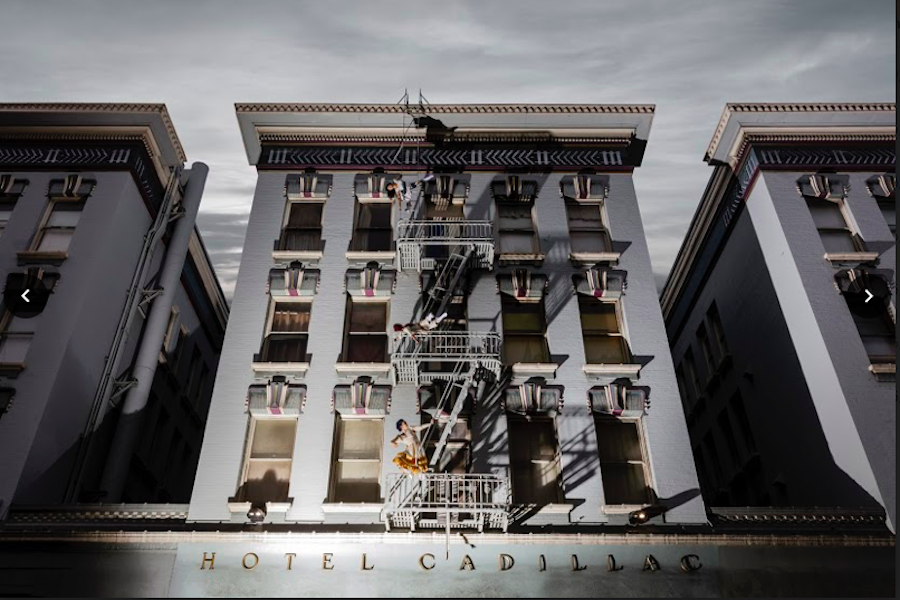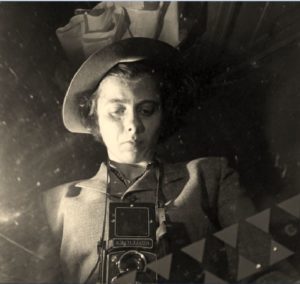The art world may wait to roll out the heavies in the fall, but summer promises plenty of new ways to engage with local art and culture.
Mark your calendars for SFMOMA's retrospective of photographer Susan Meiselas, the techie Festival of the Impossible at Minnesota Street Project, a light spectacular at The Midway, the closing of Legion of Honor's Julian Schnabel show, and more.
June
 Look for the aerial dance performance Tender (n): a person who takes charge, at Cadillac Hotel in the Tenderloin. (Photo by RJ Muna)
What: Matrix 270
Look for the aerial dance performance Tender (n): a person who takes charge, at Cadillac Hotel in the Tenderloin. (Photo by RJ Muna)
What: Matrix 270
When: Through August 28th
Where: Berkeley Art Museum and Pacific Film Archive (BAMPFA), 2155 Center Street (Berkeley),
bampfa.org
Why: Alicia McCarthy and Ruby Neri are two of the most notable artists to emerge from the Bay Area's
Mission School movement. They're showing their latest works together at
Matrix 270, BAMPFA's series of rotating contemporary art exhibitions that highlight California talent. See new paintings (McCarthy) and ceramic sculptures that upend traditional representations of the female nude (Neri).
What: Hai Bo's The Southern Series
When: Through July 15th
Where: Pace Gallery, 229 Hamilton Avenue (Palo Alto),
pacegallery.com
Why: The beauty of China is timeless. Take a deeper look in this first solo exhibition in California of Chinese artist Hai Bo, whose recent photographs taken across Southern China express the passage of time and human endurance against it. The images' power is intensified by their massive scale—at five-by-10 feet, they are large enough to erase whatever boundaries may stand between you.
What: Festival of the Impossible
When: June 8-10
Where: Minnesota Street Project, 1275 Minnesota St. (Dogpatch),
festivaloftheimpossible.com
Why: What do augmented and virtual reality have to do with art? Adobe wants to show you in this first, large-scale immersive exhibition of interactive installations created in 2D, 3D, AR, and VR.
What: Tender (n.): a person who takes charge
When: 8:30pm Thursdays, 12:30pm and 8:30pm Fridays, and 8:30pm and 9:30pm Saturdays; June 7-16
Where: Cadillac Hotel, 380 Eddy St. (Tenderloin),
flyawayproductions.com
Why: Choreographer Jo Kreiter is back on the urban stage with a site-specific, aerial dance performance that celebrates 100 years of outcast activism in the Tenderloin—from the working women who moved into the neighborhood in the early 1900s to transgender activism in the 1960s and the Vietnamese leaders who fought for immigrant rights in housing, healthcare, education, and public safety in the 1970s.
What: Soft Power
When: June 20th through July 8th
Where: The Curran, 445 Geary St. (TenderNob),
sfcurran.com
Why: It's a comedic and musical fantasia, created by Tony Award–winning playwright David Henry Hwang (
M. Butterfly) and composer Jeanine Tesori (
Fun Home), in which a Chinese executive lands in America and falls in love with a U.S. leader. Everything's going so well—until the balance of power between their two countries begins to shift.
What: 36th San Francisco Jazz Festival
When: June 6-10 and June 11-17
Where: Multiple venues,
sfjazz.org
Why: Forty-four shows in 12 days means the opportunity for full immersion in the SF jazz scene. Headliners include Ahmad Jamal, a Kennedy Center Living Jazz Legend; Irma Thomas, the "soul queen of New Orleans"; iconic electric bassist Marcus Miller; and SAG Award–winning actor/comedian Lea DeLaria. Also look for tributes to Patsi Cline and Benny Goodman.
What: Nathaniel Russell's Peace Jazz
When: Through July 25th
Where: Gallery 16, 501 3rd St. (SoMa),
gallery16.com
Why: Hope and human connections are at the foundation of the 10 large paintings displayed here by Indianapolis-based artist Nathaniel Russell.
What: Halation
When : June 9-31
Where: The Midway, 900 Marin St. (Bayview),
themidwaygallery.com
Why: Inspired by the Haruki Murakami quote, "Where there is light, there must be shadow; where there is shadow there must be light," this exhibit explores the physical meaning of creating a sense of place with light. The show will highlight SF-based tech artist Marpi's "Aquarium Project," an interactive installation of underwater creatures, and the LED star canopy "Constellation" by Burning Man regular Christopher Schardt.
What: Richard Wager's The Ring
When: June 12th through July 1st
Where: San Francisco Opera, War Memorial Opera House (Civic Center),
sfopera.com
Why: It's one of the most complex operatic journeys of all time. Originally premiered in 1876, Wagner's epic
The Ring will be staged in four parts by the SF Opera. Don't know it? You do if you've seen
Apocalypse Now (which, of course, you have). "Ride of the Valkyries"—one of the work's most famous pieces—is the tune that
blared through the helicopter speakers as the Americans bombed the beach.
JULY
 Lena on the Balmy Box, by Susan Meiselas. (Courtesy of SFMOMA)
What: Susan Meiselas: Mediations
Lena on the Balmy Box, by Susan Meiselas. (Courtesy of SFMOMA)
What: Susan Meiselas: Mediations
When: July 21st through October 21st
Where: SFMOMA, 151 3rd St. (SoMa),
sfmoma.org
Why: War, human rights, cultural identity, and domestic violence—these are just a few of the hot button topics surveyed in this compelling retrospective, the first on the West Coast, for American photographer Susan Meiselas. The exhibition will focus on the artist's projects from the beginning of her career in the 1970s to present day, including her iconic portraits of carnival strippers.
What: Richard III
When: July 14–29
Where: African-American Shakespeare Company, Taube Atrium Theater, 410 Van Ness Ave (Civic,
african-americanshakes.org
Why: Because "now is the winter of our discontent." This tale of power-lusting villains still resonates today, and maybe it even hits a little too close to home. King Edward sits on the throne at the end of the decades-long War of the Roses. But his youngest brother, Richard, has his eyes on the crown, his path to glory paved with seduction, murder, and betrayal.
What: A Thousand Splendid Suns
When: July 17-29
Where: A.C.T's Geary Theater, 415 Geary St. (Union Square),
act-sf.org
Why: Lovers of the Khaled Hosseini novel won't want to miss this stage adaptation, by Irish-Indian playwright Ursula Rani Sarma, of his story about three generations of Afghan women who are bound together, amid the war-torn streets of modern Kabul, by marriage, family, and a secret past. The show features music by renowned composer David Coulter.
What: Ranu Mukherjee: A Bright Stage
When: July 14, 2018 through January 20, 2019
Where: De Young Museum, 50 Hagiwara Tea Garden Dr. (Golden Gate Park),
deyoungmuseum.org
Why: No admission will be required to check out Mukherjee's installation that will span the four walls of the museum's Wilsey Court. With painted, printed, and animated elements, the work blurs the lines between still and moving images and is intended to amplify the space as one that is "freely accessible for public voice and action."
What:
San Francisco Ethnic Dance Festival
When: July 6-22, 2018
Where: San Francisco City Hall (Civic Center),
worldartswest.org
Why: The 40th anniversary festival is a celebrations of cultural traditions from around the world, with dance and music ensembles representing for Bolivia, Cambodia, Cuba, India, Liberia, the Philippines, Spain and more.
What: Lew the Jew and His Circle: Origins of American Tattoo
When: July 26th through December 2nd
Where: The Contemporary Jewish Museum, 736 Mission St. (SoMa),
thecjm.org
Why: San Franciscans love a good tat. This exhibition will bring to the forefront previously unpublished and rare original tattoo artwork, photos, and correspondence between famed New York artist "Lew the Jew" Alberts and SF tattooers.
What: Star Wars at the San Francisco Symphony
When: Multiple dates
Where: Davies Symphony Hall, 201 Van Ness Avenue,
sfsymphony.org
Why: You've never seen George Lucas' original
Star Wars trilogy quite like this before. See the legendary John Williams' scores performed live starting with
A New Hope (July 18-21) followed by
The Empire Strikes Back (July 26-28) and
Return of the Jedi (July 29 through Aug. 3).
What: Mangaku
When: August 24-25
Where: YBCA Theater, 710 Mission St. (SoMa),
ybca.org
Why: Dawson Dance and and saxophonist-composer Richard Howell team for their fifth collaboration, a nine-dancer ensemble inspired by (and set to) Howell's latest jazz album,
Coming of Age—Mangaku.
What: Julian Schnabel: Symbols of Actual Life
When: Through August 5th
Where: Legion of Honor, 100 34th Ave. (Sea Cliff),
legionofhonor.famsf.org
Why: It's your last chance to see Schnabel's return to the Bay Area after a 30 year wait. It was worth it: The museum's courtyard is swathed in 24-by-24-feet abstract paintings as part of the Fine Arts Museums' newly formed contemporary art program aimed at creating dialogues between living artists and the museums' classic collections.
What: Broadway Under the Stars
When: August 3-19
Where: Jack London State Historic Park, 2400 London Ranch Rd. (Glen Ellen),
transcendencetheatre.org
Why: Ready your jazz hands for one of the most acclaimed theater festivals of the season. In August, see the Gerswhin classic
Shall We Dance, based on the 1937 film starring Ginger Rogers and Fred Astaire.
What:
Evolution of Hip-Hop Dance
When: August 25th
Where: Marin Theatre Company, 397 Miller Ave. (Mill Valley),
marincenter.org
Why: You grew up with this beat. Now pay tribute to the music and dance that has had such a dramatic social impact in a performance that will show how Hip-Hop dance was born.



















































 Look for the aerial dance performance Tender (n): a person who takes charge, at Cadillac Hotel in the Tenderloin. (Photo by RJ Muna)
What: Matrix 270
Look for the aerial dance performance Tender (n): a person who takes charge, at Cadillac Hotel in the Tenderloin. (Photo by RJ Muna)
What: Matrix 270 Lena on the Balmy Box, by Susan Meiselas. (Courtesy of SFMOMA)
What: Susan Meiselas: Mediations
Lena on the Balmy Box, by Susan Meiselas. (Courtesy of SFMOMA)
What: Susan Meiselas: Mediations